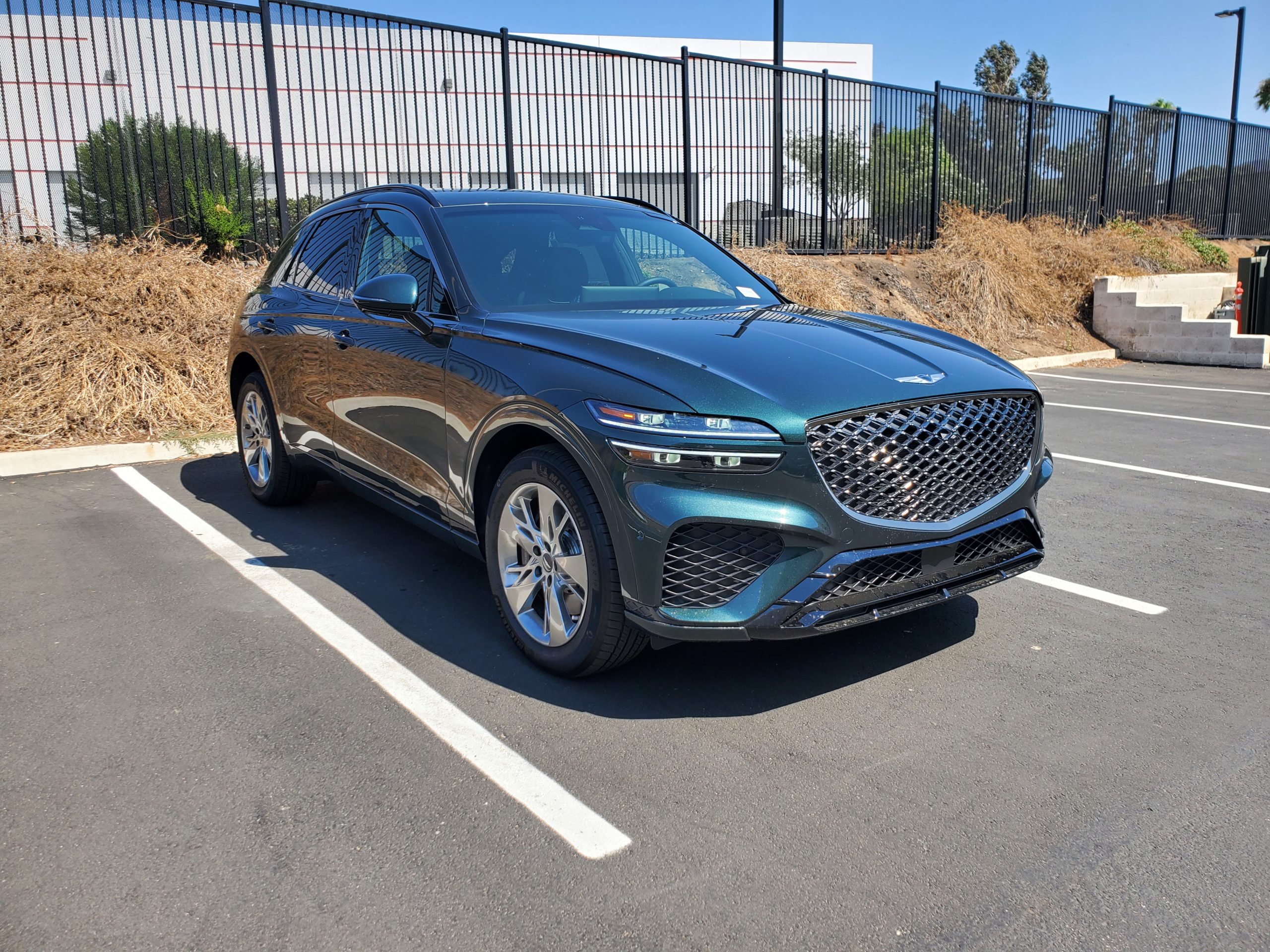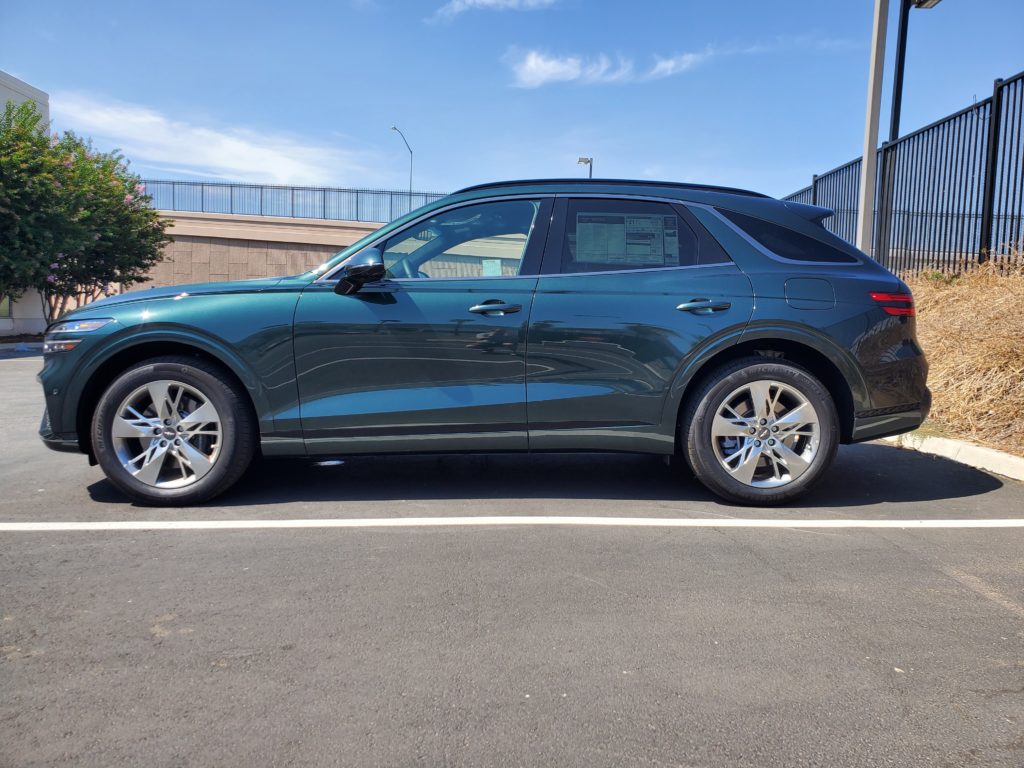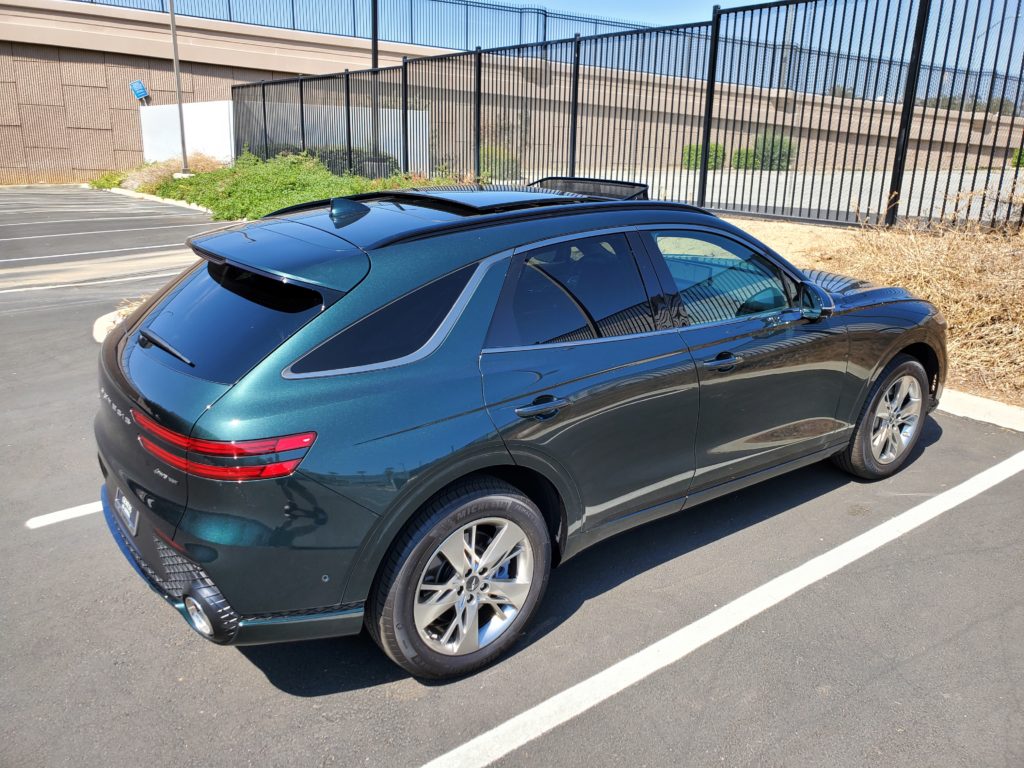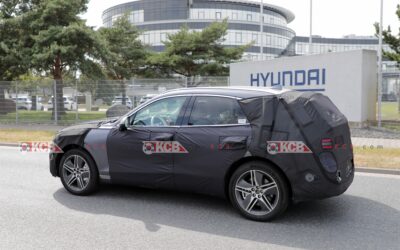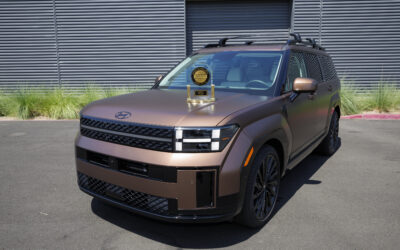Genesis’ new compact SUV, the GV70, is finally available in the United States to take on luxury competitors like the Audi Q5, BMW X3, and Lexus NX. As the hottest segment that Genesis currently competes in, the success of the GV70 is crucial for Hyundai’s luxury brand.
I had the chance to briefly drive a Cardiff Green GV70 3.5T in the Sport Advanced trim level, which is one trim level lower than the top-of-the-line Sport Prestige. From the exterior, the GV70 has a sophisticated and understated look from the front, and a sporty rear end that punches way above its weight class.
The aggressive slope of the roof, unique window trim that swoops downwards behind the C pillar, the curve on the tailgate, and the floating lower rear bumper combine for a muscular yet polished rear that’s sure to get attention. The dual narrow and long LED taillights are the newest iteration of Genesis’ signature detail. When looking at the GV70 from the side, the belt line which slopes down towards the back also hints at its underlying performance.
The main exterior differences between 2.5T and 3.5T models are the bright chrome accents on the 2.5T as opposed to black and dark chrome accents on the 3.5T, and a more angular set of exhaust pipes on the 2.5T compared to the larger circular exhausts on the 3.5T.
In terms of wheels, all GV70’s receive 19” rims, with the exception of the Sport Prestige which has dark gray 21” wheels with a sporty embossed 5-spoke pattern.
If you’re looking for performance, you’ll need to look at the 3.5T, which the tester I drove had. The twin-turbocharged V6 offers 375 horsepower and 391 lb-ft torque with standard All Wheel Drive (it’s based on a rear-drive platform). It can get from 0-60mph in 5.1 seconds thanks to its 8-speed automatic transmission. While the GV70 did feel quick, the car overall has been tuned to be quiet and luxurious rather than raucous and aggressive, and it got up to high speeds without much fanfare.
The Sport Advanced I drove did not have a Limited Slip Differential like the Sport Prestige offers, and I’m sure there’s a little more urgency to the most expensive GV70. During my drive, I always felt in command, but I was aware of the GV70’s body roll around curves, which is difficult to avoid in a taller crossover vehicle. While the GV70’s performance is impressive, it can’t match the driving experience of competitors like the Audi SQ5, Porsche Macan S, and it’s way behind the BMW X3 M40i and Mercedes GLC 43 AMG.
Of course, those vehicles will set you back substantially more than a GV70.
Where the GV70 excels is its luxurious interior. The model I tested had the Obsidian Black quilted nappa leather interior, but the GV70 is also available in beige, red, and blue interiors, all with intricate detailing (for example, the dark blue interior features bright red stitching that looks surprisingly sporty). 2.5T models have the two spoke steering wheel out of the GV80, but 3.5T models receive a more traditional three-spoke wheel.
The model I tested also had a luxurious black suede headliner, and if you go to the fully loaded GV70 Sport Prestige, you also get suede inserts on the seats too. The large panoramic sunroof had an unusually long opening section, and a very upscale overhead console which includes the controls for the sunroof and overhead lighting. There’s also really nice subtle ambient lighting that comes from behind the oval structure on the lower dashboard and under the door and center armrests. It feels premium but not overbearing.
The dashboard feels great with a large 14.5” touchscreen front and center, which is also controllable by a weighty rotary knob on the lower center console so you can fully control infotainment without lifting your arm. That knob not only rotates, but can be pushed in any direction for easy navigation of the entire system. The exterior camera system on the GV70 includes not only a top-down view but also a three-dimensional model of the car that you can move around to know exactly where you are on the road. Furthermore, you can connect to your car wherever you are and capture an image from all the cameras for peace of mind at any time.
If you opt for the Sport Prestige trim level, you’ll get a 12.3” 3D gauge cluster screen that’s unique in the industry, along with a heads up display, but the car I tested had a partial 8” screen in the right side of the gauge cluster, with a traditional speedometer and fuel gauge on the left side, and no HUD.
This feels decidedly low quality and I wish Genesis had gone all out with a full screen gauge cluster even on lower trim levels. However, on the other hand, some of the patterns on the interior trim feel extremely high quality to the touch and look amazing, and switchgear is generally good, aside from slightly cheap-feeling large plastic buttons on the steering wheel and on either side of the climate control screen.
That dual-zone automatic climate control features a secondary touch screen in a wide oval shape lower on the dashboard. This screen is super responsive and it’s nice to have a dedicated climate control screen. That screen is also where you can adjust the heated and cooled front seats and heated steering wheel.
On the Sport Advanced trim I drove, the rear climate zone was missing, but Sport Prestige models have a separate controller for the rear seats and a zone for the back. Speaking of the rear, the second row of the GV70 is very spacious, with plenty of legroom, no shortage of headroom despite the sloping roof, and comfortable reclining rear seats. All doors receive wide-style power window switches and power door locks.
Trunk space is also impressive, as it seems that Genesis made the GV70 just the right size for a 5-seat crossover. If you need more space, you’ll have to upgrade to the GV80. The GV70 also offers a fingerprint reader which acts as a secondary way to start the car (it has a traditional push-button starter too). However, it feels a little bit gimmicky and I’m not sure what value it provides.
Pricing for the GV70 is reasonable for the segment, and the 3.5T Sport Advanced model I drove had an MSRP of $59,495. Fuel efficiency is also not bad for the performance you get from the GV70 and the fact that it is a crossover, with a 19mpg city / 25mpg highway rating.
I shy away from calling the GV70 a home run, but it will satisfy buyers in this segment, and it will definitely draw attention, as it looks great and isn’t immediately noticeable due to the fact that there are still people out there who don’t even know about the Genesis brand. Now Genesis just needs to get its dealer network in better shape, and we’ll see if the brand has what it takes to make it in the competitive but profitable space the GV70 resides.

